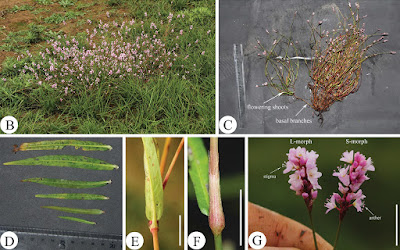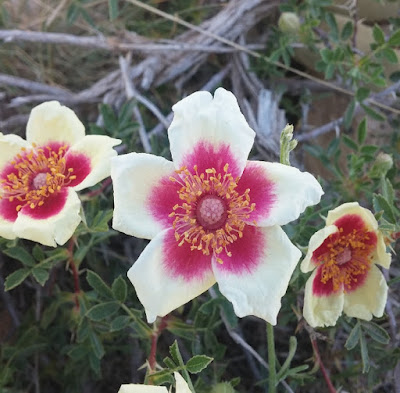[Most Recent Entries] [Calendar View]
Tuesday, July 23rd, 2019
| Time | Event | ||||
| 1:37p | [Botany • 2019] Persicaria rotunda • Persicaria jucunda var. rotunda (Polygonaceae, Persicarieae), A Distinct Distylous Taxa raised to Specific Rank
Abstract Persicaria jucunda (Meisn.) Migo var. rotunda (Z.Z.Zhou & Q.Y.Sun) Bo Li was originally published in the genus Polygonum L. and treated as a variety of P. rotundum Meisn. [≡Persicaria jucunda (Meisn.) Migo]. After carefully comparing the macro- and micro-morphological characteristics of the achenes, leaf epidermis and tepals and the habitat between the variety and its typical variety, we confirmed that P. jucunda var. rotunda is clearly different from P. jucunda and should not be treated as a variety, but be raised to a specific rank as P. rotunda (Z.Z.Zhou & Q.Y.Sun) Bo Li. The species is distylous and could be easily distinguished from all other Persicaria taxa by a combination of morphological characters, such as completely decumbent leafless basal branches, almost sessile leaves, linear-lanceolate with rounded leaf bases, spicate, short and dense inflorescences, slender pedicels longer than bracts and dimorphic flowers and achenes. P. rotunda is endemic to several large wetlands of eastern China and usually occurs as one of the dominant species in some plant communities. Keywords: Distyly, micro-morphology, new combination, Polygonum, variety
Persicaria rotunda (Z.Z.Zhou & Q.Y.Sun) Bo Li, comb. &, stat. nov. ≡Polygonum jucundum Meisn. var. rotundum Z.Z.Zhou & Q.Y.Sun, Acta Phytotax. Sin. 45(5): 714 (713–718; figs.). 2007. Type: CHINA. Anhui Province, Dongzhi County, Shengjin Lake, on riparian plains, Alt. 6–20 m, 4 October 2006, Z.Z.Zhou 0602 (holotype: PE!, isotype: ANU). ≡Persicaria jucunda (Meisn.) Migo var. rotunda (Z.Z.Zhou & Q.Y.Sun) Bo Li, Phytotaxa. 91 (1): 24. 2013. Diagnosis: This species is easily distinguished from other Persicaria taxa by its completely decumbent leafless basal branches, almost sessile leaves, truncate, linear-lanceolate leaf blades, spicate, short and dense inflorescences, pedicels longer than bracts and dimorphic flowers and achenes. It occurs as one of the dominant species of some lakeshore plant communities in several large wetlands of northern Jiangxi and south-western Anhui provinces, eastern China. Distribution and habitat: Persicaira rotunda is currently known only from several wetlands in north of Jiangxi Province and southwest of Anhui Province, eastern China and mainly grows in marshy and grassy areas around Daguan Lake, Lihu Lake, Longgan Lake, Poyang Lake Qingcao Lake, Shengjin Lake, Shimeng Lake and Wuchang Lake, which are several small to large lakes located near the Yangtze River. It usually occurs as one of the dominant species of some lakeshore plant communities (Fig. 1A). Yue-Ning Guo, Shao-Feng Chen, Ming-Lin Chen and Bo Li. 2019. Persicaria jucunda var. rotunda (Polygonaceae, Persicarieae), A Distinct Distylous Taxa raised to Specific Rank. PhytoKeys. 126: 127-138. DOI: 10.3897/phytokeys.126.35442 | ||||
| 1:43p | [Botany • 2019] Origin of Rosa × binaloudensis (Rosaceae), A New Natural Hybrid Species from Iran
Abstract Rosa x binaloudensis, a new natural hybrid between R. beggeriana and R. persica is described and characterized after analyzing a set of morphological and molecular data. The putative hybrid with a small population occurs in the mountainous area of northeastern Iran. This taxon resembles R. beggeriana in having white corolla and pinnately compound leaves but its petals have red blotch at the base of each more similar to R. persica. In the morphological study we performed both the univariate and multivariate analyses. Results of Mann-Whitney U test show that among 62 vegetative and floral morphological traits used, 37 (59%) of the hybrid characters are parental-like, 14 (23%) traits are intermediate and 11 (18%) appear to be transgressive (both new and extreme characters). Multivariate analyses (PCoA) generally show that the hybrid is intermediate between its putative parents. In the molecular study we amplified, cloned, and sequenced ribotypes (nuclear rDNA-ITS region) of the hybrid, its putative parents and all members of the subgenus Rosa to detect their possible involvement in the hybridization. In addition to phylogenetic tree reconstruction, due to low molecular resolution among the ITS ribotypes, a phylogenetic network was also provided. Both the phylogenetic tree and haplotype network analysis confirmed the occurrence of the hybridization between the proposed parental species, R. beggeriana and R. persica. By using the chloroplastic trnL-F sequences, our phylogenetic reconstruction revealed that R. persica has played as a maternal role in the hybridization. Keywords: Rosaceae, hybridization, morphology, molecular phylogeny, network, Eudicots Rosa x binaloudensis Jamil Vaezi, Ali Asghar Arjmandi and Hamid Reza Sharghi. 2019. Origin of Rosa x binaloudensis (Rosaceae), A New Natural Hybrid Species from Iran. Phytotaxa. 411(1); 23–38. DOI: 10.11646/phytotaxa.411.1.2 | ||||
| 2:22p | [PaleoOrnithology • 2019] Conflicto antarcticus • A Stem Anseriform from the early Palaeocene of Antarctica provides New Key Evidence in the Early Evolution of Waterfowl
Abstract A new Anseriformes, Conflicto antarcticus gen. et sp. nov., represented by associated bones of a single individual, from the early Palaeocene of Antarctica is described. The new taxon is unlike any other known member of the order. Conflicto antarcticus is a medium-sized (2 kg) stem anseriform. The forelimb and pectoral girdle bones suggest that it was a flying bird, and the bones of the hindlimb show that it had elongated legs. The os quadratum represents a unique combination of features; some are similar to the features of the ancestral quadrate for galloanserines and some are similar to Anseriformes, but features such as the presence of three foramina are exclusive among Neornithes. The incisura or foramen nervi suracoracoidei is absent in C. antarcticus, as in most anatids and all Galliformes. Phylogenetic analysis shows that C. antarcticus + Anatalavis oxfordi is the most basal stem Anseriformes clade. This implies that the duck-type beak must have developed at an early stage of anseriform evolution. Conflicto antarcticus represents one (and possibly the most) substantial record of a non-marine Palaeocene bird from the Southern Hemisphere and supports the hypothesis that Neognathae had already diversified in the earliest Palaeocene. Keywords: Antarctica, Anseriformes, Conflicto antarcticus, Palaeocene, phylogeny SYSTEMATIC PALAEONTOLOGY Aves Linnaeus, 1758 Neognathae Pycraft, 1900 Galloanseres Sibley & Ahlquist, 1990 Order Anseriformes (Wagler, 1831) Incertae familiae Conflicto gen. nov. Derivation of name: Conflicto, from the Latin conflictus (contradiction, masculine in gender), owing to the controversial systematic position of the taxon. Conflicto antarcticus sp. nov. Derivation of name: Relative to the geographical area of origin, Antarctica. Claudia P. Tambussi, Federico J. Degrange, Ricardo S. De Mendoza, Emilia Sferco and Sergrio Santillana. 2019. A Stem Anseriform from the early Palaeocene of Antarctica provides New Key Evidence in the Early Evolution of Waterfowl. Zoological Journal of the Linnean Society. 186(3); 673–700. DOI: 10.1093/zoolinnean/zly085 Nueva clave para comprender la evolución del pico de pato conicet.gov.ar/nueva-clave-para-comprend |
| << Previous Day |
2019/07/23 [Calendar] |
Next Day >> |















